Tourist attractions in Quy Nhon
Surely you have heard a lot about tourist attractions in Quy Nhon, right? However, before creating a Quy Nhon travel itinerary , you need to know the most famous and beautiful tourist destinations here. Let’s explore more information about all of them with Focus Asia Travel right now!
Eo Gio Bay
Eo Gio Bay is 20 km northeast of Quy Nhon city center which is famous for its wild beauty. Here you will have beautiful angles and scenery.
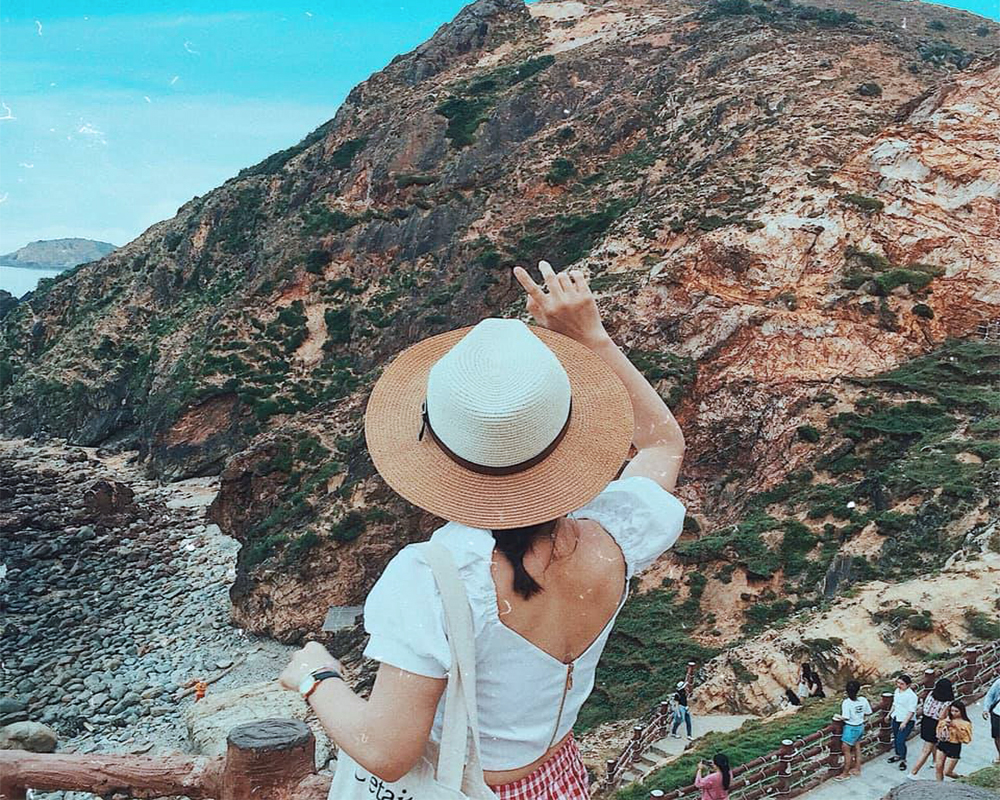
Eo Gio is surrounded by an extremely curved bow-shaped mountain range. Because of its topographical characteristics – a saddle-like hollow, located between two high mountain tops close to the sea – so it was named Eo Gio, which means “Strait of wind”. Initially standing here, admiring the rocky mountains, cliffs of all shapes embracing the entire sea, watching the extremely clear blue water and listening to the sea breeze “sing” by your ear, you will not say anything. . But when you return, you will be a travel inspiration for your friends to see.
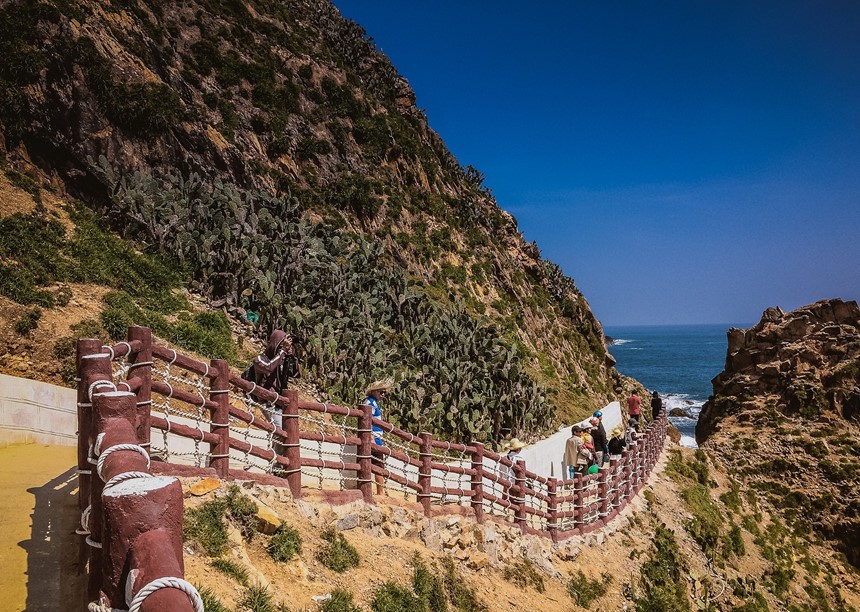
Wind Waist
On the cliff side, there are many funny caves such as Ky Co cave, Ba Nghe cave … attracting a lot of swiftlets to live and nest. Around the strait is green grassland, sometimes you will see herds of goats grazing, or a couple taking wedding photos. Next to that is the “laying stone” beach with stones like eggs, of all sizes and colors, creating a very beautiful natural picture. All seem to blend together perfectly.
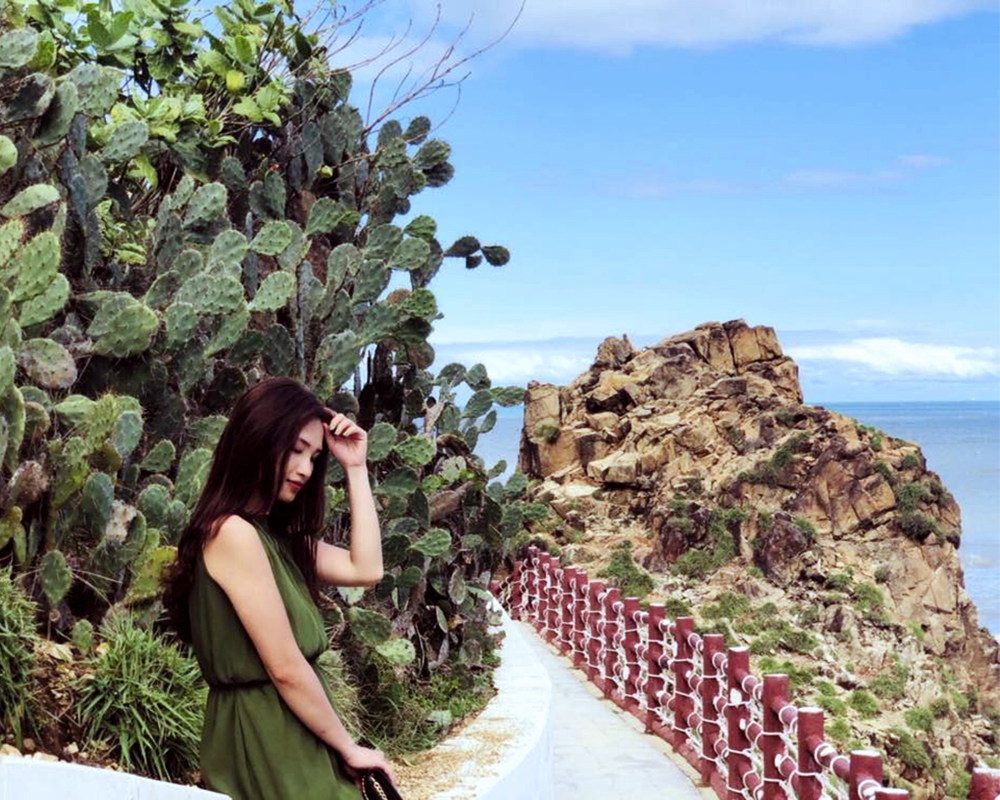
Because this is a fishing village, not a famous tourist destination, the atmosphere is extremely peaceful, the people are extremely hospitable. Come here once this summer, to know how beautiful Vietnam is, and discover for yourself the masterpieces of nature.
See also: Top 5 famous landscapes of Quy Nhon
Ky Co
Try to experience a trip with many surprises and interesting things with Quy Nhon city – home to Ky Co beach , which brings a pristine beauty with white sand, brilliant yellow sunshine and clear blue sea. This is the tourist destination attracting the most tourists in Quy Nhon.
Located nearly 25 km from Quy Nhon city, Ky Co belongs to Nhon Ly island commune with wild beauty. This is a place that has not yet been exploited for tourism, still very wild.
From Quy Nhon city, you cross Thi Nai bridge to Phuong Mai peninsula, from Phuong Mai peninsula drive along Highway 19 B, then turn to Nhon Ly island commune. Coming to Nhon Ly island commune, there will be 2 ways for you to choose:
- 1 is riding a motorbike across the mountain road to get to the island, but the road is under construction so it will be difficult to go and requires you to have hard steering wheel.
- 2 is booking a tour to Ky Co, canoeing to the beach, this is my recommended way, because you will see the coral too. Canoeing time is about 15 minutes from the mainland to Ky Co beach, the canoe runs quite fast so you will not get seasick.
Coming to Ky Co beach, you will see the wonderful beauty of this beach. The beach is a combination of rocks rising in the middle of the sea with cool, clear blue water. Here, you can enjoy swimming and take souvenir photos together here.

After that, take a boat to return to Dua beach near the mainland to see the beautiful corals; vast coral reefs with many colors; flocks of small avocado fish spread along with other interesting marine life. You can get your hands on the beautiful coral reefs. When you return to the mainland in the afternoon, you will shower and change.
You must definitely taste the rustic but unique flavors in Ky Co such as: all kinds of grilled snails, grilled abalone, crab, steamed squid, grilled urchin, … at the restaurant. Surely one thing, anyone who has ever visited Ky Co will always have a desire to come back here, to be immersed in blue water; enjoy holidays like paradise in this sea.
See more: Top 5 most beautiful beaches in Binh Dinh
Trung Luong picnic area
Trung Luong picnic area is one of the beaches quite familiar to the people as well as visitors to Binh Dinh. From Quy Nhon, visitors follow Nhon Hoi bridge road to come to this romantic beach.
Just arriving at Trung Luong Picnic Area, you will immediately meet the restaurant with harmonious decoration. Here you can enjoy the dishes with a rich flavor of the sea. Shrimp, fish, squid, sauteed, crabs, … caught by local fishermen and will be grilled, fried, steamed or a steaming hot pot. Just thinking about it also feels delicious.
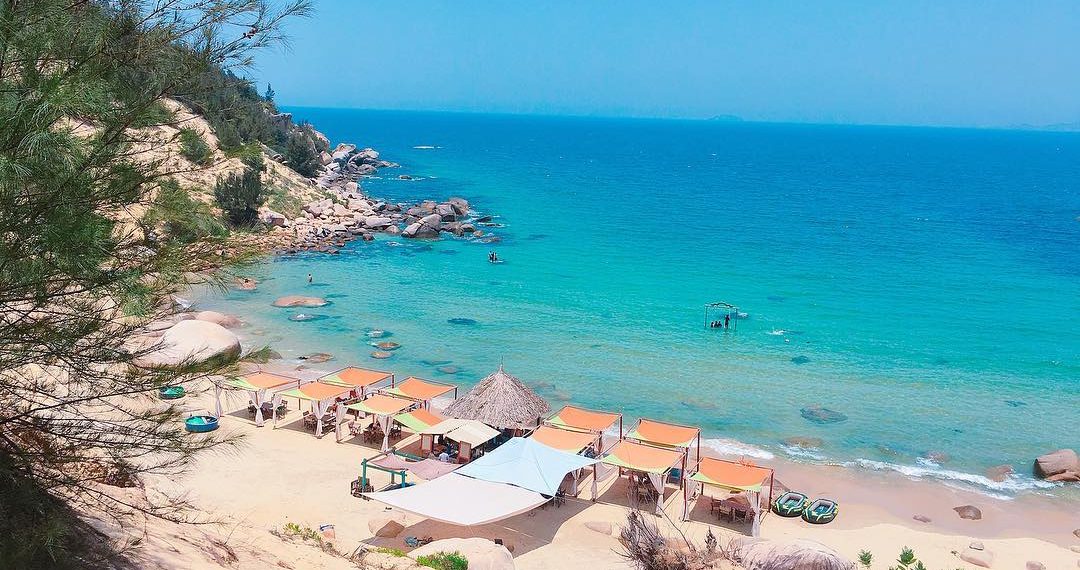
Next is the play area with green meadows, colorful chairs and lovely tents facing the sea. Surrounding this camping area is surrounded by large limestone rocks and forests, sometimes the sea breeze blows, making people just want to stay forever. You can also experience a night at Trung Luong Picnic in these small huts. Join your friends in the group games, then set the bonfire and enjoy singing and dancing and surely it is indispensable to watch the stars together, tell each other about story of plans for a long time cherished.
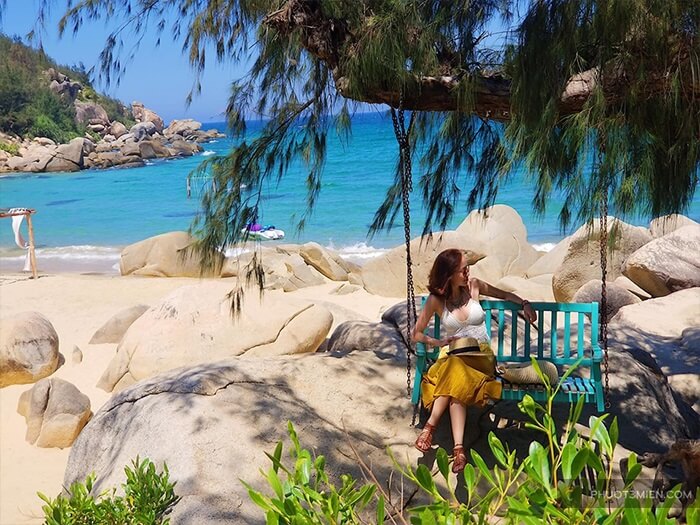
Don’t be in a hurry to turn around until we finish the soft paved path that winds along the mountainside. Here we can admire Trung Luong beach, which exudes a wild, rustic and very fresh look. The blue sea sparkles with silver light, a few basket boats gently drifting on the water, let your bare feet freely play with the smooth white sand.
Trung Luong picnic area is like a gentle folk song that gently enters the hearts of every visitor. How can I forget this simple yet so dear picture of the sea. Packed with the scent of the sea, the smell of sunshine and the wind as a gift for the distant guests who have fallen in love with the “village girl” Trung Luong. Let Trung Luong strange land add vibrant colors to your summer days!
Quang Trung Museum
From TP. Quy Nhon, follow Highway 19 to the northwest more than 42km, visitors will come to Phu Phong town – the home of 3 Tay Son brothers, Nguyen Nhac, Nguyen Hue and Nguyen Lu … Crossing the Kien My bridge across Con River with two banks of green mulberry fields, the house lines looming behind bamboo groves, visitors will come to the complex of Quang Trung museum relic; includes two main works: Quang Trung museum and Tay Son Tam Kiet temple. The museum has 9 galleries with many artifacts related to the Tay Son uprising movement and the hero Quang Trung – Nguyen Hue.
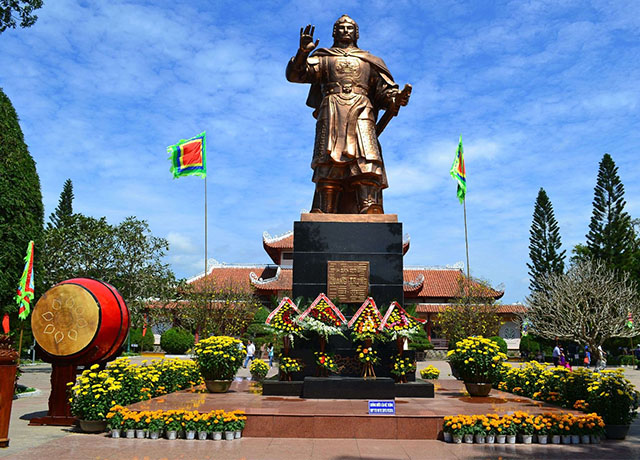
Up to now, in the old garden of Quang Trung’s family, there are still two extremely precious relics: the old well and the old tamarind tree, which are said to date from the time of Ho Phi Phuc (the birthplace of Tay Son three brothers). The old water well is located to the right of Tay Son Palace with a diameter of 0.9m. The original was built of laterite and not as deep as it is now because villagers later restored it to make a common well for the whole village.
Next to the power is a large old tamarind tree shading a corner of the garden, according to the people here, the tree’s circumference is up to 3.5m. After a long day of coming here to visit the relic and learn about history, there is nothing like sitting under the old mother to draw a pot of sacred water to increase the morale as hero Nguyen Hue.
Quang Trung Binh Dinh Museum is not only a place to keep historical artifacts but also a place to convey the spirit of Tay Son ethnic martial arts – traditional martial arts of Binh Dinh. In order to increase the liveliness of martial dances, the people here even recreated the old drums of King Quang Trung.
Visiting Quang Trung Binh Dinh museum, visitors will have the opportunity to go upstream of history to live with the spirit of chivalry, indomitable resilience and patriotism through the majestic history of the Tay Son uprising. the glorious victory of Nguyen Hue and loyal close generals.
Ham Ho
Ham Ho is located in Tay Phu commune, Tay Son district, Binh Dinh province, 50km northwest of Qui Nhon city. Ham Ho has a charming natural landscape, of which the highlight is about 3km long river section. In the riverbed, there are many giant granite rocks with interesting shapes such as: Ball, Double Stone, Bell Stone, Stone Thanh, Go Island, Ban Co Stone … Especially, on the left bank of the river section there are Ham Ho waterfall – a result of the sudden folding of the topography of the river, the strong flow of water downwards creates a waterfall.
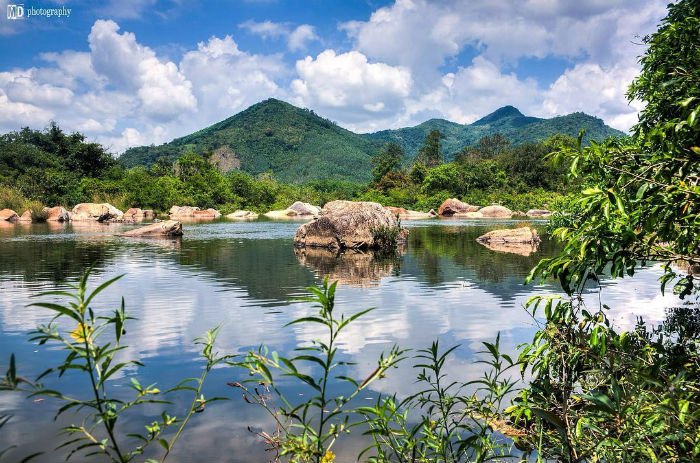
In the rainy season, fishes go upstream to spawn and must cross Ham Ho waterfall. Legend has it that in the past, every year, fish gathered here to cross the waterfall, the dragon that passed it was turned into a dragon, so it was also called Ca Bay waterfall or Vu Mon waterfall. The two sides of the river are green with forest trees, mainly purple myrtle, sesame buds. This is the habitat of cuckoo, humpback, ring-ring, gecko …
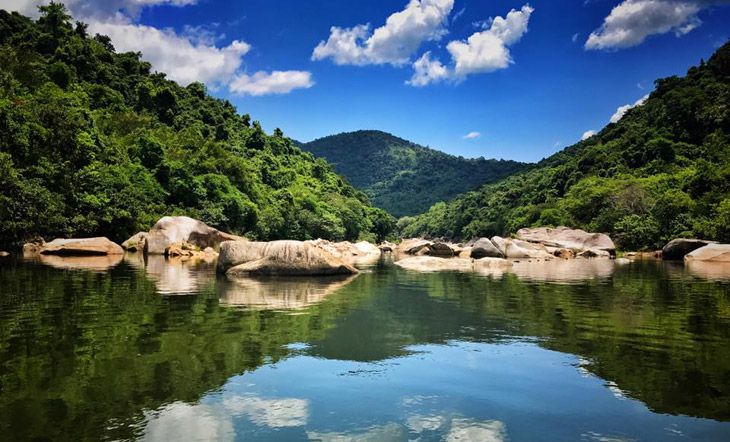
It was here that, more than two hundred years ago, the general Vo Van Dung trained troops to practice martial arts and then joined forces with the Tay Son leaders to raise the flag of insurrection. Later, Mai Xuan Thuong was the marshal of the Can Vuong army in Binh Dinh from mid-1885 to mid-1887. Based on the rugged mountain position of Ham Ho, the insurgency led by him caused many losses to the French. and fright. After that, you will visit historical sites such as Bay Cu cave, Tien Hien palace, …
In addition, you can also participate in exciting and exciting water activities such as kayaking, fishing, … together with campfire activities, watching cultural performances, listening to songs in hut and enjoying many dishes. eating special cuisine such as perch, fried fish with rice paper rolls, little cakes, …
Ong Nui Temple
Ong Nui pagoda , also known as Linh Phong Thien Tu, is located in Phuong Phi village, Cat Tien commune, Phu Cat district with the wild beauty of To cave located on the middle of a mountain behind the pagoda. Up to now, 12 inheritance generations and every year there is Ong Nui pagoda festival on the 24-25th of the first lunar month – the anniversary of the death of Mr. To Vien Minh of the pagoda. On this occasion, there are thousands of people in the province and tourists on pilgrimage to visit the Buddha, admire the scenery and come to the To cave to offer incense to admire the merits of Mr. Nui, pray for a peaceful and prosperous new year.
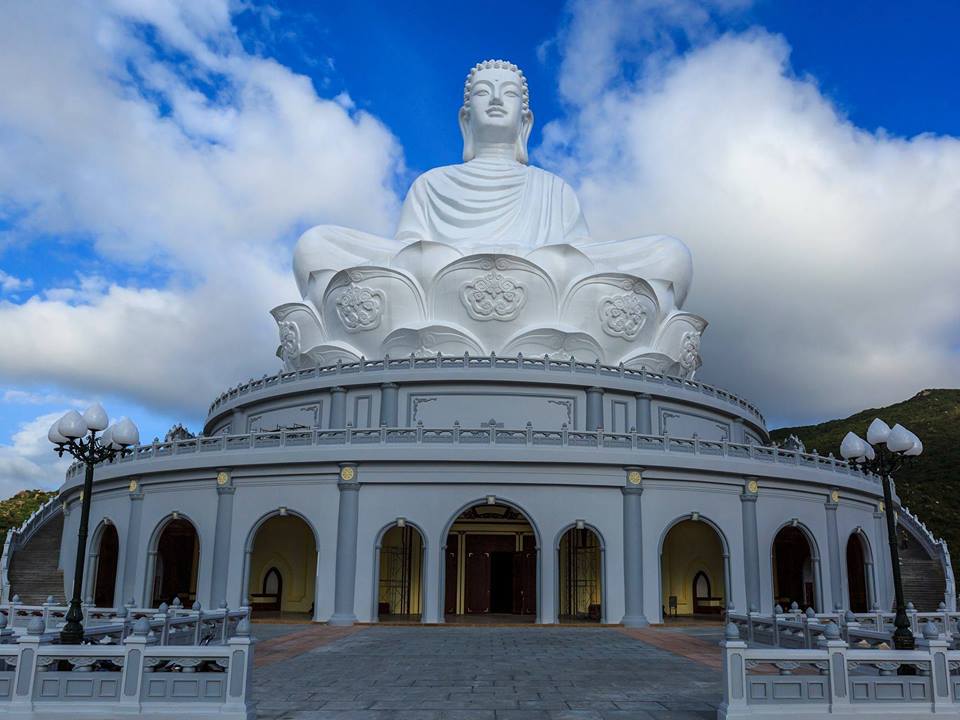
To reach the gate of Linh Phong pagoda , visitors have to walk through hundreds of stone steps from the foot of Ba mountain to the height of more than 100m. From here, you can see the majestic Ba mountain range, peaceful village scene at the foot of the mountain, far away is the panorama of Nhon Hoi economic zone beside Thi Nai lagoon, right next to Quy Nhon city. The temple grounds are always cool thanks to the canopy of ancient trees such as phoenix, jackfruit, eagle, … and there are many willows and flowers planted around the large, clear lake. The shrines are designed spaciously but still retain the spirit, the red tiled roofs, undulating under the canopy of old trees, the straight columns on the pagoda’s porch and the walkways create an ancient solemnity.
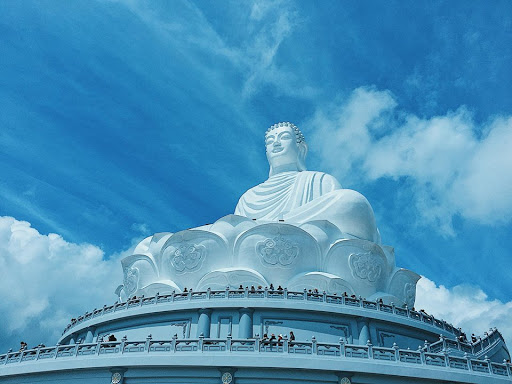
The deep smell of incense lingering in the middle of the Zen place makes people’s hearts quieter. From the front of the temple hall with the Buddha statue, going to the west there is a small bridge leading up to the tombs of the Tower and up to the To Cave located on the mountain behind the pagoda. To cave is located close to the edge of the stream, natural rocks cover all three sides like a house. Legend has it that this is the rock cave in the old days when Mr. Nui used to stay, used to sit and recite Buddhist scriptures.
In 2000, the statue of Mr. Nui (Zen master Le Ban) was built, located in To cave. The sitting statue 84 cm high, golden stalactite, made by artist Le An, is still intact with its wild beauty with cliffs from the inside and the surrounding landscape. Inside the cave are natural cliffs, creating many interconnected spaces like the rooms of a stone house.
Green Islet
Cu Lao Xanh in Nhon Chau island commune, Quy Nhon city, Binh Dinh province, 24km from the mainland, is considered “Hon Ngoc Bien Dong”, with an area of about 364 hectares with a population of about 3,000 people.
Cu Lao Xanh is beautiful all year round, but you should avoid the end of July and August because this is a time of heavy storms that will jeopardize your Quy Nhon travel. Also in winter you should not go. The ideal time to explore the island is February to June, September, October.
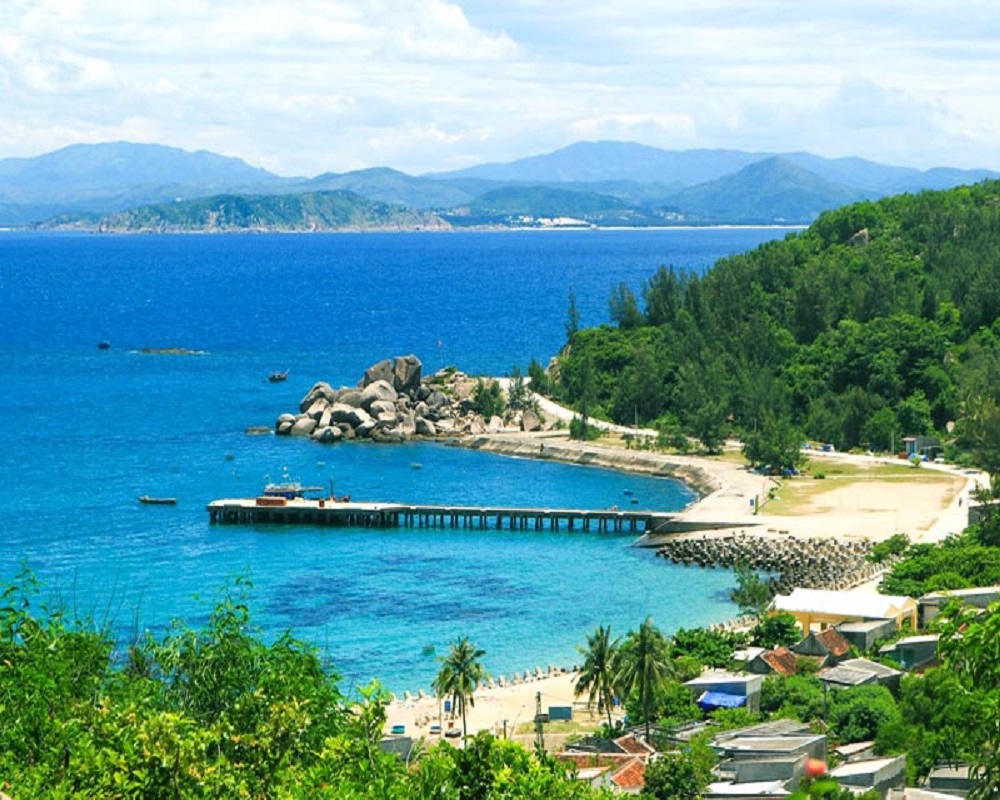
True to its name, this small island is like a green pearl in the middle of the sea with beautiful scenery from the endless green space of trees covered and to the color of the sky and sea. The beach on the island is still quite unspoiled, clear water, gentle sand strip and rocky beach with many shapes created by the nature. The sea water is clear so it is easy for you to dive (face down) to watch the corals. In addition to this is a sense of environmental protection, it is also possible to avoid trouble because the border guard will carefully check it.
Cu Lao Xanh lighthouse is the fusion of two gothic styles of the West and Eastern architecture. The foot of the tower consists of 32 steps built with brick; Tower body is cylindrical, inside there is a spiral staircase 58 steps. From the lighthouse, panoramic view of the blue sea and peaceful island life can you see the endless beauty of this destination.

Next to the lighthouse is the national flagpole project which was started construction on July 8, 2014. The flagpole of the Fatherland on the island of Green isle is designed to be 22.66m high, fabric flag size 4 x 6m; has a square base of 2.2 × 2.2m, and is 5.05m high, built of granite. Behind the flagpole, there are 2 reliefs of the logo of the Ho Chi Minh Communist Youth Union and the Vietnamese Student Association of Granite stone facing the Hoang Sa archipelago, clearly stating the sovereignty, longitude and latitude of the green Cu Lao island.

Island accommodation services are not really developed, only hostels, you can ask the locals about homestay services and order meals; Immerse yourself in the life of a fisherman. Especially, around 3am, islanders often turn on lights on boats to pick up squid and jump.
Twin towers
The Twin Towers in Quy Nhon is also known as Hung Thanh Twin Towers, a beautiful and unique work of ancient Cham architectural art; located in the heart of Quy Nhon city, the last tourist destination in Quy Nhon.
Quy Nhon Twin Towers was built at the end of XII century; consists of 2 adjacent tower blocks, the big tower is 20m high, the smaller tower is lower, both located on a relatively flat terrain; is highly appreciated by researchers for both having a typical architectural space of the Champa tower; both brings Khmer art style in Ancovat-Bayon period. Quy Nhon Twin Towers has been ranked as a national monument since 1980.
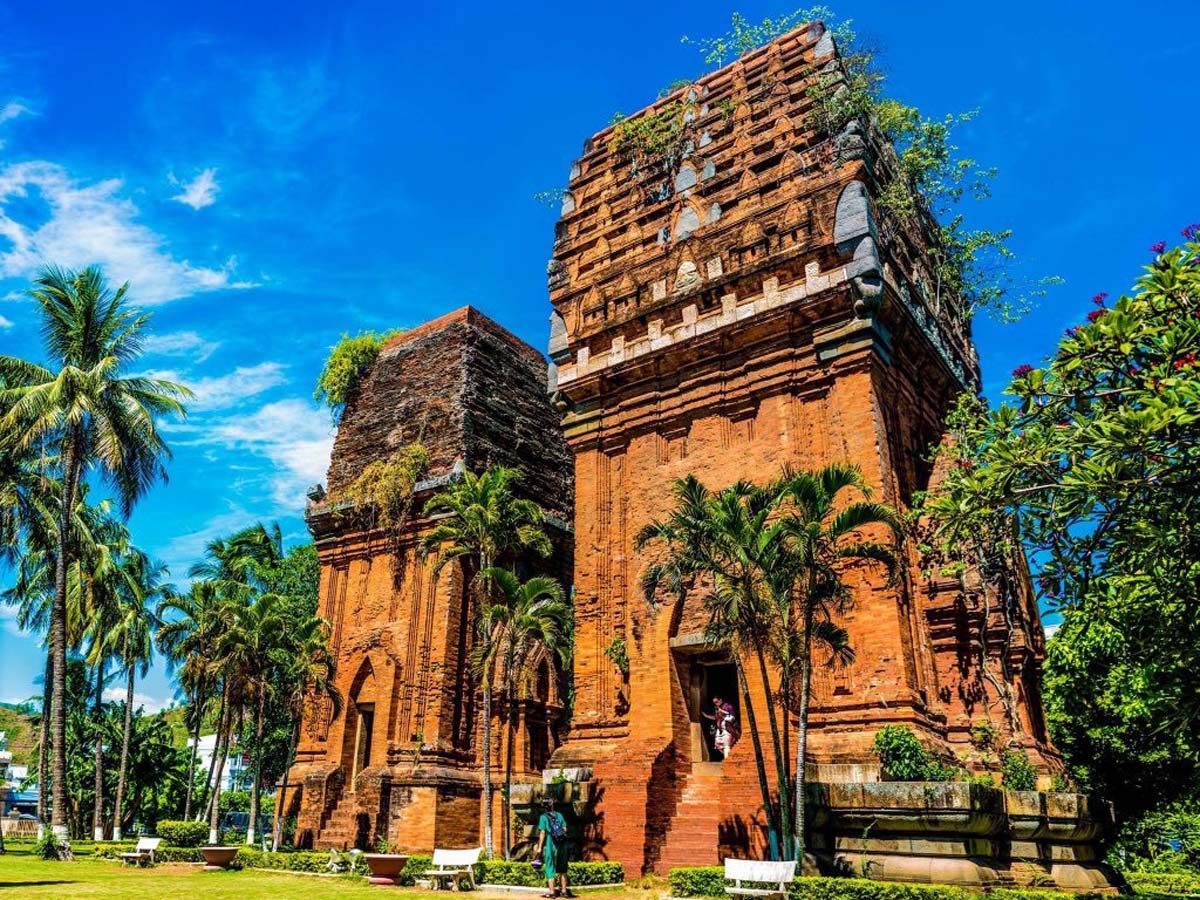
Both towers are not the traditional multi-storey square tower of Champa, but are structured into two main parts: the square body and the top of the tower with curved surface. Therefore, at first glance at this tower, it seems to have the shape of a Khmer temple in the 12th century.
The body is square, the outer wall surface is arranged with fake doors and cladding columns running along the body. Arches on fake doors on all three sides create a towering javelin, smooth cladding columns. Between the two cladding columns is a high protrusion into solid, strong lines; and is surrounded by an inward wall line; there are no decorative stripes on the outside of the tower wall.
Above are Quy Nhon tourist sites famous and attracting the most tourists. If you come to Quy Nhon, do not forget to share the best photos with Focus Asia Travel .










